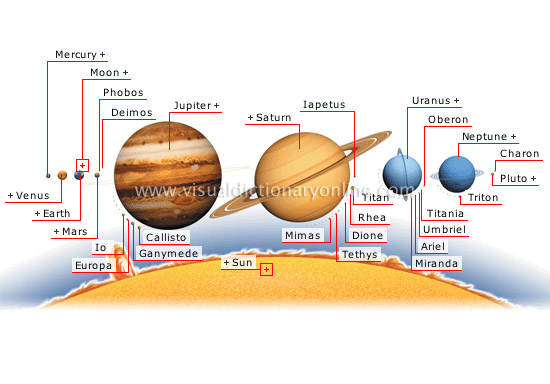planets and satellites
Planets, dwarf planets and plutoids orbit the Sun, satellites orbit the planets. They are represented from left to right from the Sun, based on their relative sizes.
Sun 
Star around which the planets gravitate; represents over 99.8% of the total mass of the solar system.
Jupiter 
Fifth planet from the Sun, also the largest; Jupiter is 1,330 times the size of Earth.
Io 
Satellite of Jupiter; the celestial body with the greatest number of active volcanoes.
Europa 
Satellite of Jupiter; displays a surface layer of ice that might cover liquid water.
Callisto 
Satellite of Jupiter; its heavily cratered surface indicates that Callisto is very old.
Ganymede 
Satellite of Jupiter; the largest natural satellite in the solar system; its glacial surface is thought to cover an ocean and a mantle.
Mercury 
The planet closest to the Sun; devoid of atmosphere, heavily cratered and marked by extreme variations in temperature (-300°F to 800°F).
Venus 
Second planet from the Sun; its density and chemical composition are similar to those of Earth.
Earth 
Third planet from the Sun, inhabited by humankind; up to now, the only planet with evidence of life.
Moon 
Earth’s only natural satellite; devoid of water and atmosphere and characterized by a highly uneven surface.
Phobos 
Satellite of Mars; slightly larger than Deimos, Phobos features a large crater named Stickney.
Mars 
Fourth planet from the Sun; its crust contains iron oxide, giving Mars its reddish color.
Deimos 
Satellite of Mars; one of the smallest natural satellites in the solar system, its surface displays numerous craters.
Saturn 
Sixth planet from the Sun, also the second largest planet; Saturn is encircled by rings forming a band about 120,000 mi in diameter.
Titan 
Saturn’s largest satellite, 1.5 times the diameter of the Moon.
Uranus 
Seventh planet from the Sun, also the third largest planet; Uranus is composed mainly of rock, ice and hydrogen and features 11 rings.
Pluto 
Discovered in 1930, it was long considered the ninth planet of the solar system. Since 2008, it has been classified as a plutoid.
Charon 
Pluto’s only satellite; almost equal in size and mass to the planet itself.
Triton 
Neptune’s largest satellite; together with Pluto, Triton is the coldest object in the solar system.
Neptune 
Eighth planet from the Sun; its atmosphere, composed of hydrogen, helium and methane, gives Neptune its bluish color. Features four rings.
Rhea 
Satellite of Saturn; its cratered surface is covered with ice as hard as rock.
Dione 
Satellite of Saturn; its cratered surface features ice deposits.
Tethys 
Satellite of Saturn thought to be composed of ice; visible on its surface is an immense impact crater named Odysseus.
Mimas 
Satellite of Saturn; features a crater named Herschel spanning one-third of its surface.
Oberon 
The most distant satellite of Uranus; its craters are often surrounded by light rays.
Titania 
The largest satellite of Uranus; its surface displays numerous valleys and faults.
Umbriel 
Satellite of Uranus; its heavily cratered surface is very dark.
Ariel 
Satellite of Uranus; its cratered surface is composed of numerous long valleys and extremely high escarpments.
Miranda 
Satellite of Uranus whose surface is cratered in places; displays vast expanses of arêtes and furrows.
Iapetus 
Satellite of Saturn featuring a bright side composed of ice and a dark side composed of unknown matter.



















